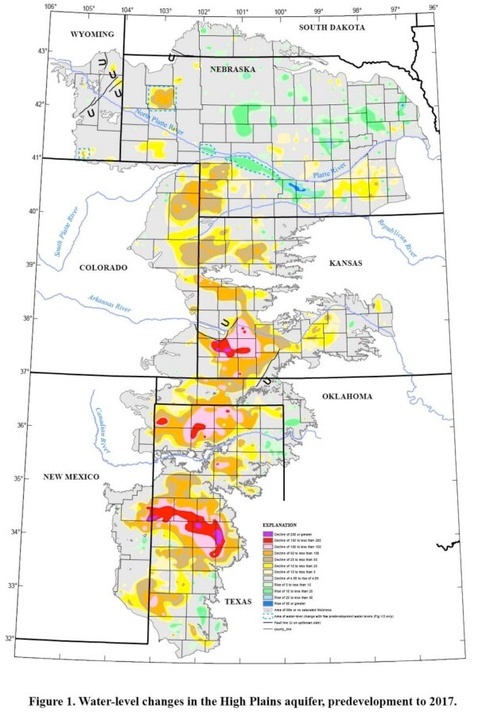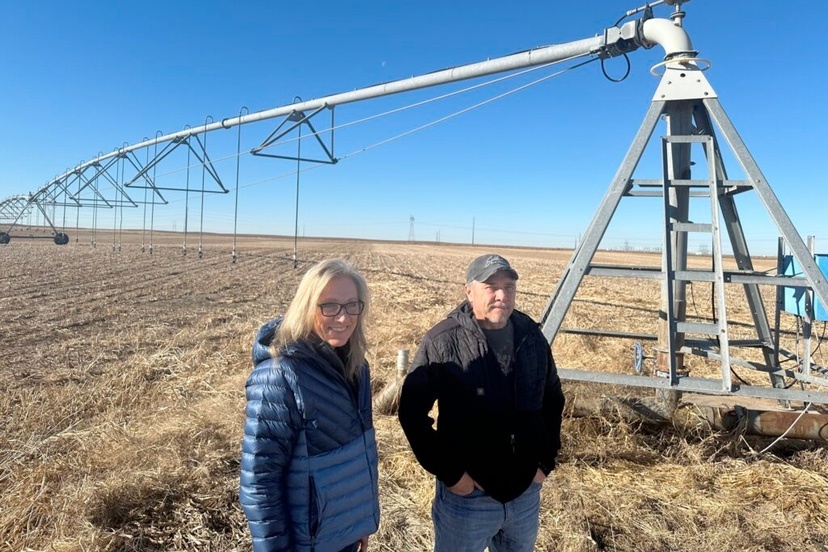Photo: Gina and Marc Gigot stand in front of a center pivot irrigation system on their farm outside of Garden City, Kansas. The farm has historically been among the largest water users in Kansas, but it has cut usage in recent years as part of voluntary conservation measures aimed at slowing the decline of the Ogallala Aquifer. (Kevin Hardy/Stateline)
This story by Allison Kite and Kevin Hardy appeared on Colorado Newsline on January 30, 2024. It’s the first in an occasional series about water challenges facing the American heartland, from a partnership between Stateline and the Kansas Reflector. We are sharing it in two parts.
In Kansas, the Ogallala Aquifer supplies 70% to 80% of the water residents use each day. But for decades, the state’s regulation of water benefited its largest user and its largest industry: agriculture.
The once-abundant water allowed farmers to grow cheap cattle feed, attracting the feedlots, and increasingly, dairy farms, that dot southwest Kansas.
But that feed is cheap, partly because — aside from the fuel costs associated with running a well — the water is free.
A report commissioned by the Kansas legislature in 1955 warned of a future without it.
“Ground-water mining is a serious problem,” the report says.
After the grave 1955 warning, however, the state legislature only made it easier to pump the water, according to Burke Griggs, a water law professor at Washburn University in Topeka.
Griggs, formerly a water lawyer for the state, criticized Kansas lawmakers’ decadeslong posture that depletion would best be solved locally. He said it is a stance held by every governor since the 1980s.
“They want it to be voluntary. And they want it to be cooperative. They want to have local-based solutions,” Griggs said. “These are the catchwords you hear. None of them have achieved much.”
Kelly follows the same line. The second-term governor recently signed a law mandating more reporting and planning from groundwater management districts and created a new subcabinet to coordinate water issues across agencies. But she hasn’t wavered from her position that water conservation efforts are most effective when they are voluntary.
“Things are more likely to work out in the long run and succeed if there is local buy-in, and local commitment and the idea is generated locally — rather than the state wielding that heavy hammer,” Kelly said.
But even some farmers want the state to step in, water policy watchers say.
“Many families who are trying to make a living from farming, and who would like to keep farming on their own land, are just waiting for the state to step in and help them fix this. Most people agree that we need fair, enforceable and transparent rules to get this turned around,” said Lucas Bessire, a professor of anthropology at the University of Oklahoma who grew up in southwest Kansas.
For the first time since their father dug an irrigation well in the dusty sandhills of southwest Kansas more than 50 years ago, Gina and Marc Gigot’s farm isn’t growing corn.
The sibling farmers are trying to preserve the precious water below their land outside Garden City.
For decades, the Gigot family has benefited from drawing groundwater to the surface to grow bright green circles of crops where the sandy soil is otherwise so dusty it might blow away.
As Marc’s pickup bumps along the farm’s private roads, he and Gina point to the electric systems and water pipes laid by their father. Some of the massive center pivot systems use the same parts he installed 50 years ago.
To extend the life of the aquifer, the siblings are opting for fewer water-intensive crops and grazing cattle. The farm has historically been among Kansas’ largest water users, irrigating 9,000 acres, but they’ve cut their usage in recent years and committed to another 10 years of voluntary water conservation.
In exchange, they get more flexibility in how they use the water. As long as they hit their five-year goal, they can pump more water in drought years.
Beyond that, they’re partnering with Garden City, the largest city in southwest Kansas and a major agricultural hub. Garden City’s municipal water wells sit right next door to the Gigot farm, which can directly impact the city’s ability to supply drinking water.
To keep more water underground, Garden City will soon divert treated wastewater to the Gigot farm — rather than continuing to dump it into the bone-dry bed of the Arkansas River. That will allow the farm to turn off some wells.
“It’s not really a situation where either the city gets what they need or the irrigators get what they need. It is way more symbiotic,” said Fred Jones, who oversees Garden City’s water.
In northwest Kansas, a group of farmers voluntarily cut their water usage by 20% through a five-year conservation program with the state. They switched from corn to wheat or grain sorghum and used irrigation more strategically. Farmers in the area exceeded their goal and cut use, on average, 23.1% over the initial five-year period and slowed the decline of the aquifer from 2 feet per year to less than half a foot.
Still, the Gigots said the state must force other producers to cut back.

Even Kansas Farm Bureau President Joe Newland said he’s fearful that voluntary efforts aren’t enough.
Newland, a former Kansas Republican legislator, offered an amendment in 2022 that effectively sank a massive bill designed to make the aquifer a higher priority in state government, impose more requirements on local groundwater officials, and give communities a greater voice in decisions over water.
In Kansas, the agricultural industry, led in part by Newland, has largely pushed back against aggressive water restrictions, instead calling for voluntary conservation measures. But Newland worries that those voluntary measures haven’t saved enough water, which could eventually push the state to hand down strict mandates.
“I’m always hopeful and prayerful that people realize just how important it is that we’re doing this on a voluntary basis and not ever have to go through a mandatory situation,” he said. “But that’s going to be determined in the near future how this works, because, as I said, we don’t have decades to fix this problem.”
Few places evoke the Old West like Dodge City, where Wyatt Earp patrolled the lawless streets rife with gambling, saloons and shootouts.
Today, the city proudly displays remnants of those days at the Boot Hill Museum, which contains a reproduction of the legendary Long Branch Saloon and an Old West photo booth for visitors.
But the former frontier outpost has embraced some of the state’s most progressive water strategies.
“We were recycling before recycling was cool,” said City Manager Nick Hernandez, who highlighted water reuse efforts that began in the 1980s.
Effluent from one of the city’s wastewater treatment plants keeps a golf course green. Another plant sends about 1.8 billion gallons of treated wastewater to irrigate 3,000 acres of crops at a nearby farm, reducing the need for aquifer pumping.
Another project aims to directly recharge the aquifer with treated wastewater. That will not only help protect the city’s quantity of water, but also prevent contamination from agricultural runoff like nitrates by keeping the hydraulic pressure up in city wells, he said.
That project is expected to cost $60 million. Dodge City, home to about 28,000 people, is seeking federal and state assistance for the effort. But even without grants, Hernandez said that would prove cheaper than buying water rights and digging new wells.
All those projects are building toward treating the city’s sewage directly into drinkable water — still an emerging idea in most parts of the country. That would allow the city to decrease demand on groundwater by continually reusing its water.
“We all have a concern about the stability of the aquifer because that’s our lifeline,” said Ray Slattery, the city’s director of engineering services. “But I feel very good about where the city is, and what we’ve done in the past to conserve. We knew it was important and so we took steps way before it became a problem.”
Communities such as Dodge City offer a glimpse into the future of municipal water supplies in the region, said state Rep. Jim Minnix, a Republican who represents part of western Kansas and leads the House Water Committee.
Minnix, who raises cattle and farms both dryland and irrigated crops, said cities and farms alike must adapt. Cities need to continue embracing water recycling efforts, reduce lawn watering and encourage more efficient appliances. Farmers, he said, should embrace new technologies such as more efficient irrigation systems and drought-resistant crops.
“You’d be amazed at the water quantity that’s actually being saved out there from what had been done 40, 50 years ago,” he said. “As a farmer myself, I know a lot of little things add up to something that’s really worthwhile. And to maintain our aquifer and our economy out here is absolutely worthwhile.”
But the way Connie Owen, director of the Kansas Water Office, sees it, change is coming to both agricultural and municipal water users one way or another.
“If we don’t adapt to different behaviors, it will run dry,” she said. “And that will cause the economic devastation that everyone fears with restrictions.”

